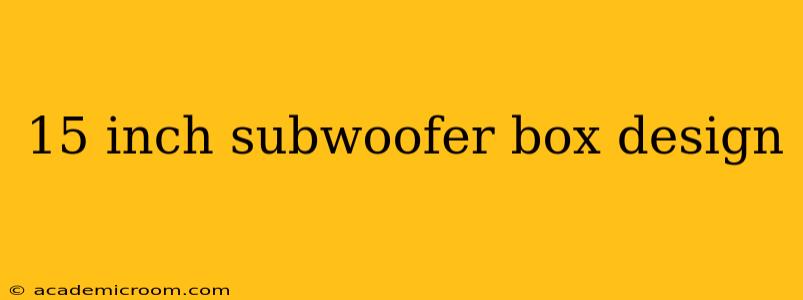Choosing the right enclosure for your 15-inch subwoofer is crucial for achieving optimal sound quality and performance. A poorly designed box can lead to muddy bass, distortion, and even damage to your subwoofer. This guide will walk you through the key considerations for designing a 15-inch subwoofer box, covering various enclosure types and design parameters.
What are the Different Types of Subwoofer Boxes?
Several enclosure types cater to different subwoofer applications and desired sound characteristics. The most common include:
-
Sealed (Acoustic Suspension): Sealed boxes are simple to build, offering tight and accurate bass with good transient response. They are generally less efficient than ported designs, meaning they need more power to achieve the same output level. However, they are less prone to distortion and are often preferred for high-quality audio reproduction in critical listening environments.
-
Ported (Bass Reflex): Ported boxes utilize a port (tube) to enhance bass output and extend the low-frequency response. This results in louder and more impactful bass, but at the expense of potentially losing some accuracy and transient response. Proper port tuning is critical to avoid undesirable resonance peaks and dips.
-
Bandpass: Bandpass enclosures are more complex, using multiple chambers and ports to create a narrow frequency range boost. They offer extreme bass extension but are very sensitive to design parameters and can be challenging to build and tune accurately. These are generally used in specific applications where extreme low-frequency output is needed, such as car audio competitions.
-
Horn: Horn-loaded subwoofers use a horn structure to load the subwoofer's output, resulting in exceptionally high efficiency and very loud bass. However, horns are large, complex, and require precision design and construction.
What Factors Influence 15-Inch Subwoofer Box Design?
Several factors influence the design of your 15-inch subwoofer enclosure:
-
Subwoofer Specifications: Consult your subwoofer's specifications (found in the manufacturer's documentation). Crucial parameters include the subwoofer's Thiele-Small (T/S) parameters (Fs – resonant frequency, Vas – equivalent compliance, Qts – total Q factor, etc.). These parameters are essential for accurate enclosure design.
-
Enclosure Type: As discussed above, the choice of enclosure type (sealed, ported, bandpass, horn) significantly impacts the final design and sound characteristics.
-
Desired Bass Response: Do you prioritize deep bass extension, accuracy, or loudness? This will guide your choice of enclosure type and design parameters.
-
Available Space: The physical dimensions of your available space will constrain the size and shape of your subwoofer enclosure.
How Do I Calculate the Internal Volume of My 15-Inch Subwoofer Box?
The internal volume of your enclosure is a critical parameter. For sealed enclosures, you'll often target a volume close to the subwoofer's Vas. For ported enclosures, WinISD or similar subwoofer box design software will calculate the optimal volume based on the T/S parameters and desired tuning frequency.
What is the Optimal Tuning Frequency for a Ported 15-Inch Subwoofer?
The tuning frequency of a ported enclosure influences the low-frequency response. It's typically chosen to optimize the output in the desired frequency range. Again, subwoofer box design software will help determine the optimal tuning frequency based on your subwoofer's T/S parameters and desired bass response.
What Software Can I Use to Design a Subwoofer Box?
Several software packages facilitate subwoofer box design. Popular options include WinISD, BassBox Pro, and others. These programs use the subwoofer's T/S parameters to calculate the optimal enclosure dimensions and port parameters.
What Materials Should I Use to Build My 15-Inch Subwoofer Box?
Common materials for subwoofer enclosures include MDF (medium-density fiberboard), plywood, and particleboard. MDF is generally preferred for its stiffness, damping properties, and relative ease of construction. Ensure that the material is appropriately thick to minimize resonance and vibrations.
How Do I Optimize My 15-Inch Subwoofer Box for Sound Quality?
Optimizing your 15-inch subwoofer box involves careful attention to design, construction, and placement:
- Accurate Measurements: Precisely measure and cut the enclosure components to minimize errors.
- Proper Bracing: Internal bracing stiffens the enclosure, reducing unwanted resonances.
- Damping Material: Using damping material (like polyfill) inside the enclosure can help absorb internal reflections and reduce unwanted coloration.
- Port Design: For ported enclosures, the port's length, diameter, and shape significantly influence the tuning frequency and airflow.
- Placement: The subwoofer's placement in the room can drastically affect its sound. Experiment with different locations to find the best spot.
This guide offers a foundational understanding of 15-inch subwoofer box design. Remember that accurate design requires careful consideration of your subwoofer's specifications and the desired sonic characteristics. Utilizing subwoofer box design software is highly recommended for accurate and optimized results. Remember to always prioritize safety when working with power tools.
